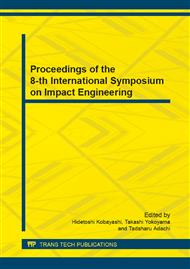p.140
p.146
p.152
p.158
p.167
p.173
p.179
p.185
p.193
Mechanical Behavior of Polycrystalline Aluminum under Penetration with Extremely Large Loading Rates via Molecular Dynamics Simulation
Abstract:
In this study, polycrystalline aluminum nanoscale thin sheets are constructed by sputter deposition simulations with the molecular dynamics (MD) simulation. Subsequently, the penetration problem of a conical rigid projectile moving through the aluminum thin sheet is simulated by the MD technique. The MD simulations adopted the interatomic potential of a tight-binding type. During the deposition simulation, in order to include the ion-ion interactions, the pair-wise Moliere potential was adopted to model the interaction between working gas argon and deposited atoms. The as-deposited films did not show clear grain boundaries, but after thermal annealing, grains grow and form nanocrystalline structure with a grain size of 8 nm. The thin sheets consisted of the face-centered cubic phases of crystal unit cells, separated by grain boundaries. For the penetration simulations, four velocities were chosen 102, 103, 104 and 105 m/s. The first two velocities are called high velocity case and the rest two velocities are the hypervelocity case. Our results show that, as the penetration rate increases, more stresses are required to move the projectile through the Al film due to temperature effects from the high velocity to hypervelocity case. In addition, defects, such as dislocations, increase during the projectile penetration. In the high velocity case, the penetrated hole in the film may be recovered, but not in the hypervelocity case. The temperature difference increased in the hypervelocity case is significantly than that in the high velocity case.
Info:
Periodical:
Pages:
167-172
Citation:
Online since:
June 2014
Authors:
Price:
Сopyright:
© 2014 Trans Tech Publications Ltd. All Rights Reserved
Share:
Citation:


